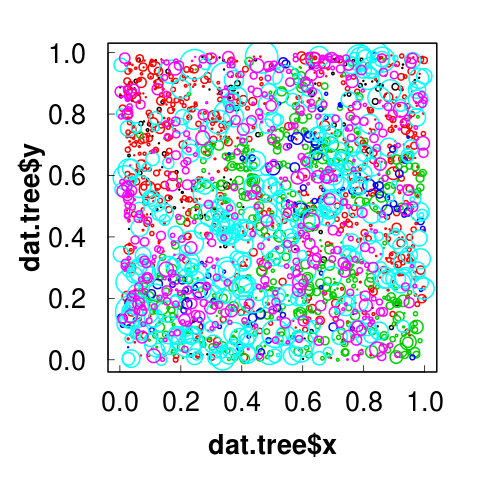FES 720 Introduction to R
The Split-Apply-Combine Strategy for Data Analysis
Problem: How to calculate mean tree DBH per species?

Problem: How to calculate mean tree DBH per species?
head(dat_tree)
# x y species dbh status
# 1 0.078 0.091 blackoak 0.85 1
# 2 0.076 0.266 blackoak 0.90 1
# 3 0.051 0.225 blackoak 1.11 1
# 4 0.015 0.366 blackoak 0.18 0
# 5 0.030 0.426 blackoak 0.32 1
# 6 0.102 0.474 blackoak 0.11 1
str(dat_tree)
# 'data.frame': 2251 obs. of 5 variables:
# $ x : num 0.078 0.076 0.051 0.015 0.03 0.102 ...
# $ y : num 0.091 0.266 0.225 0.366 0.426 0.474 ...
# $ species : Factor w/ 6 levels "blackoak","hickory",..: 1 ...
# $ dbh : num 0.85 0.9 1.11 0.18 0.32 ...
# $ status : int 1 1 1 0 1 1 1 0 1 1 ...

Solution 1: pull out data for each species at a time
- tedious and time-consuming
- high chance of errors
# subset out blackoak
bo <- dat_tree[dat_tree$species == "blackoak", ]
head(bo)
# x y species dbh status
# 1 0.078 0.091 blackoak 0.85 1
# 2 0.076 0.266 blackoak 0.90 1
# 3 0.051 0.225 blackoak 1.11 1
# 4 0.015 0.366 blackoak 0.18 0
# 5 0.030 0.426 blackoak 0.32 1
# 6 0.102 0.474 blackoak 0.11 1
mean(bo$dbh)
# [1] 1.258519
Solution 2: run a loop
- time-consuming and tedious
- lower chance of errors
Split-apply-combine is a common data analysis pattern
Split: Break a big problem into manageable pieces
Apply: operate on each piece independently
Combine: stick pieces back together
Examples of split-apply-combine
Data preparation
- group-wise ranking
- standardization
- normalization
- creating new variables on a per-group basis
Summaries for display or analysis
- checking sample sizes of groups
- calculating marginal means
- conditioning table of counts by groups
Modelling
- fitting separate models for groups (=panel)
Equivalents in other software
Excel pivot tables
APL’s array operators
SQL ‘group by operator’
apply()
When you want to apply a function to the rows or columns of a matrix (and higher-dimensional analogues).
# Two dimensional matrix
M <- matrix(seq(1,16), 4, 4)
M
[,1] [,2] [,3] [,4]
[1,] 1 5 9 13
[2,] 2 6 10 14
[3,] 3 7 11 15
[4,] 4 8 12 16
# apply min to rows
apply(M, 1, min)
[1] 1 2 3 4
# apply max to columns
apply(M, 2, max)
[1] 4 8 12 16
Not generally advisable for data frames as it will coerce to a matrix first.
If you want row/column means or sums for a 2D matrix, look at highly optimized, lightning-quick colMeans(), rowMeans(), colSums(), rowSums()
lapply()
When you want to apply a function to each element of a list in turn and get a list back.
x <- list(a = 1, b = 1:3, c = 10:100)
x
$a
[1] 1
$b
[1] 1 2 3
$c
[1] 10 11 12 13 14 15 ... 100
lapply(x, FUN = length)
$a
[1] 1
$b
[1] 3
$c
[1] 91
lapply(x, FUN = sum)
$a
[1] 1
$b
[1] 6
$c
[1] 5005
sapply()
When you want to apply a function to each element of a list in turn, but you want a vector back, rather than a list.
x <- list(a = 1, b = 1:3, c = 10:100)
# Compare with above; a named vector, not a list
sapply(x, FUN = length)
a b c
1 3 91
sapply(x, FUN = sum)
a b c
1 6 5005
# lapply:
lapply(x, FUN = sum)
$a
[1] 1
$b
[1] 6
$c
[1] 5005
# sapply:
sapply(x, FUN = sum)
a b c
1 6 5005
tapply()
For when you want to apply a function to subsets of a vector and the subsets are defined by some other vector, usually a factor
z <- data.frame(x = 1:20,
y = factor(rep(letters[1:5], each = 4))
)
z
x y
1 1 a
2 2 a
3 3 a
4 4 a
5 5 b
6 6 b
7 7 b
8 8 b
9 9 c
10 10 c
11 11 c
12 12 c
13 13 d
14 14 d
15 15 d
16 16 d
17 17 e
18 18 e
19 19 e
20 20 e
# Add up the values of x
# within each subgroup defined by y:
tapply(z$x, z$y, sum)
a b c d e
10 26 42 58 74
Functional Programming
R is a functional programming language.
It provides many tools for the creation and manipulation of functions
Anything you can do with vectors, you can do with functions:
- assign them to variables,
- store them in lists,
- pass them as arguments to other functions,
- create them inside functions,
- return them as the result of a function.
Example: Replacing ‘-99’ with ‘NA’
-
Find and replace in Excel. yikes!
- Hard code equivalent in R:
df$a[df$a == -99] <- NA- For every missing value…?
- What if value changes?
- Functional programming:
- Create function that replaces ‘-99’ with ‘NA’.
- Apply that function to each column.
Advantages of functional programming this example
Code is more compact.
Can update missing value easily, and in one place.
Code works for any number of columns.
Cannot accidentally miss columns.
Cannot treat one column differently to another.
Can generalise even further.
Other resources
Background on functional programming
http://adv-r.had.co.nz/Functional-programming.html
http://www.bioinformaticszen.com/post/simple-functional-programming-in-r/
Other details of *apply
https://nsaunders.wordpress.com/2010/08/20/a-brief-introduction-to-apply-in-r/
https://stackoverflow.com/questions/3505701/grouping-functions-tapply-by-aggregate-and-the-apply-family
https://www.slideshare.net/hadley/plyr-one-data-analytic-strategy